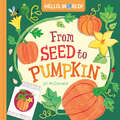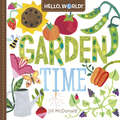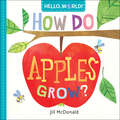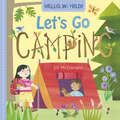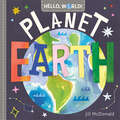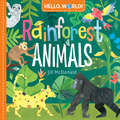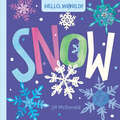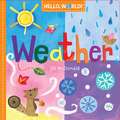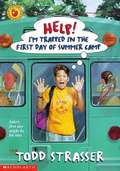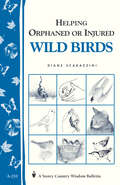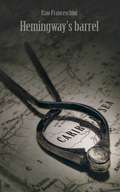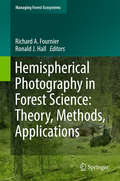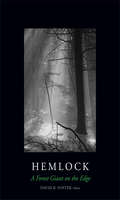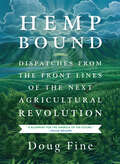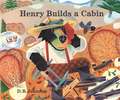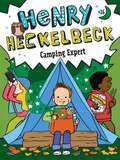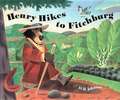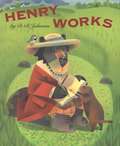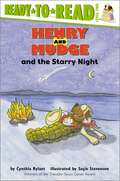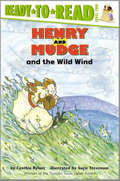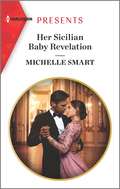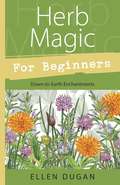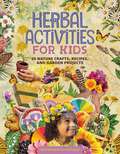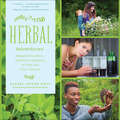- Table View
- List View
Hello, World! From Seed to Pumpkin (Hello, World!)
by Jill McDonaldHow do pumpkins grow? Families can explore fall's favorite fruit together in this nonfiction board book from the bestselling series Hello, World! A perfect autumn or Halloween gift!Kids can learn all about how pumpkins grow in this cheerful and informative board book—with colors, shapes, sizes, and super-simple facts. ("Prize-winning pumpkins can weigh as much as a rhinoceros!")Told in easy-to-understand terms alongside bright illustrations of seeds, sprouts, vines, flowers, and—best of all—pumpkin pies and jack-o-lanterns, this sturdy book makes learning easy for little ones and offers useful prompts to help adults engage with the reader on each page.It's a perfect way to bring nature and gardening into the busy world of babies, toddlers, and preschoolers, where learning never stops.
Hello, World! Garden Time (Hello, World!)
by Jill McDonaldLearn from home and explore the world with these fun and easy board books!This cheerful and informative Hello, World! board book teaches toddlers all about gardens—with easy-to-understand facts about how plants grow and how gardening puts food on our tables.Hello, World! is a series designed to introduce first nonfiction concepts to babies and toddlers. Told in clear and easy terms ("Roots spread into the soil below, and then a shoot pushes up out of the earth") and featuring bright, cheerful illustrations, Hello, World! makes learning fun for young children. And each sturdy page offers helpful prompts for engaging with your child. It's a perfect way to bring science and nature into the busy world of a toddler, where learning never stops.Look for all the books in the Hello, World! series: • Solar System• Weather• Backyard Bugs• Birds• Dinosaurs• My Body• How Do Apples Grow?• Ocean Life• Moon Landing• Pets• Arctic Animals• Construction Site• Rainforest Animals• Planet Earth • Reptiles• Cars and Trucks • Music• Baby Animals• On the Farm• Garden Time• Planes and Other Flying Machines• Rocks and Minerals• Snow
Hello, World! How Do Apples Grow? (Hello, World!)
by Jill McDonaldLearn from home and explore the world with these fun and easy board books!Young children love to eat apples and go to orchards. Here's a Hello, World! board book that teaches toddlers all about how apples grow—from seed to sapling to tree to applesauce.Hello, World! is a series designed to introduce first nonfiction concepts to babies and toddlers. Told in clear and easy terms ("Apple seeds start to grow when they are planted in soil and given sunlight, water, and fresh air") and featuring bright, cheerful illustrations, Hello, World! is a perfect way to bring science, nature, and culture into the busy world of a toddler, where learning never stops.Look for all the books in the Hello, World! series: • Solar System• Weather• Backyard Bugs• Birds• Dinosaurs• My Body• How Do Apples Grow?• Ocean Life• Moon Landing• Pets• Arctic Animals• Construction Site• Rainforest Animals• Planet Earth • Reptiles• Cars and Trucks • Music• Baby Animals• On the Farm• Garden Time• Planes and Other Flying Machines• Rocks and Minerals• Snow
Hello, World! Let's Go Camping (Hello, World!)
by Jill McDonaldFamilies who camp can prepare for their next trip together with this nonfiction board book from the bestselling series Hello, World! A perfect gift for outdoorsy kids!Kids can learn all about the joys of camping in this cheerful and informative board book—with colors, shapes, sizes, and super-simple facts. ("Stars look brighter when you are camping because there are no other lights around.")Told in easy-to-understand terms alongside bright illustrations of tents, camper vans, gear, marshmallow roasts, and stargazing, this sturdy book makes learning easy for little ones and offers useful prompts to help adults engage with the reader on each page.It's a perfect way to bring the outside world of nature into the busy world of babies, toddlers, and preschoolers, where learning never stops.Look for all the books in the Hello, World! series: • Solar System• Weather• Backyard Bugs• Birds• Dinosaurs• My Body• How Do Apples Grow?• Ocean Life• Moon Landing• Pets• Arctic Animals• Construction Site• Rainforest Animals• Planet Earth • Reptiles• Cars and Trucks • Music• Baby Animals• On the Farm• Garden Time• Planes and Other Flying Machines• Rocks and Minerals• Snow• Let's Go Camping• School Day
Hello, World! Planet Earth (Hello, World!)
by Jill McDonaldLearn from home and explore the world with these fun and easy board books!Toddlers love to learn about the solar system. Here's a book all about our amazing planet Earth, with easy-to-understand facts about countries, continents, oceans, landforms, habitats, and Earth's place in space. Hello, World! is a series designed to introduce first nonfiction concepts to babies and toddlers. Told in clear and easy terms ("Light from the sun makes the moon shine") and featuring bright, cheerful illustrations, Hello, World! makes learning fun for young children. And each page offers helpful prompts for engaging with your child. It's a perfect way to bring science and nature into the busy world of a toddler, where learning never stops. Look for all the books in the Hello, World! series: • Solar System• Weather• Backyard Bugs• Birds• Dinosaurs• My Body• How Do Apples Grow?• Ocean Life• Moon Landing• Pets• Arctic Animals• Construction Site• Rainforest Animals• Planet Earth • Reptiles• Cars and Trucks • Music• Baby Animals• On the Farm• Garden Time• Planes and Other Flying Machines• Rocks and Minerals• Snow
Hello, World! Rainforest Animals (Hello, World!)
by Jill McDonaldThe latest in the hit Hello, World! board book series teaches toddlers all about the amazing world of a rainforest—with easy-to-understand facts about the incredible animals who make their home there.Hello, World! is a series designed to introduce first nonfiction concepts to babies and toddlers. Told in clear and easy terms ("Croak! What's that sound? It's the red-eyed tree frog.") and featuring bright, cheerful illustrations, Hello, World! makes learning fun for young children. And each page offers helpful prompts for engaging with your child. It's a perfect way to bring science and nature into the busy world of a toddler, where learning never stops. Look for all the books in the Hello, World! series: Solar System, Weather, Backyard Bugs, Birds, Dinosaurs, My Body, How Do Apples Grow?, Ocean Life, Moon Landing, Pets, Arctic Animals, and Construction Site.
Hello, World! Snow (Hello, World!)
by Jill McDonaldThe hit Hello, World! board book series teaches toddlers all about snow! Includes easy-to-understand facts about chilly weather, snowflakes, storms, snowplows, and winter fun.Young children love to play in the snow. Now Hello, World! can teach them all about winter weather—with colors, shapes, sizes, and super-simple facts. ("Snowflakes come in different shapes, but they all have six sides and six points.")Told in clear and easy terms and featuring bright, cheerful illustrations, Hello, World! makes learning fun for young children. Each page offers helpful prompts for engaging with your child.It's a perfect way to bring science and nature into the busy world of a toddler, where learning never stops.Look for all the books in the Hello, World! series: • Solar System• Weather• Backyard Bugs• Birds• Dinosaurs• My Body• How Do Apples Grow?• Ocean Life• Moon Landing• Pets• Arctic Animals• Construction Site• Rainforest Animals• Planet Earth • Reptiles• Cars and Trucks • Music• Baby Animals• On the Farm• Garden Time• Planes and Other Flying Machines• Rocks and Minerals• Snow
Hello, World! Weather (Hello, World!)
by Jill McdonaldHello, World! is a series designed to help parents introduce simple nonfiction concepts to babies and toddlers. Now even the youngest children can enjoy learning about the world around them.Weather takes children through the seasonal changes in a backyard, showing them how a yard changes throughout the year: on a summer day the flowers are bright and a puppy plays on the green lawn; on a snowy day we see the same yard blanketed with snow; on a windy day the clothesline flaps in the breeze. Children can also have fun pointing to pictures of the different clothing we wear in each type of weather: mittens, hats, rain boots, and more. Told in an easy, friendly tone (“Look out the window. What is the weather like today?”) and featuring bright, cheerful illustrations, Hello, World! makes learning easy for young children. And each page offers helpful prompts for engaging with your child. It’s a perfect way to bring natural science into the busy world of a toddler, where learning never stops. “Written as simple questions and answers, this format provides just enough information for curious toddlers.”—Kirkus
Help! I'm Trapped in the First Day of Summer Camp
by Todd Strasser<p>Been there, Done that. Jake Sherman's first day of summer camp seems strangely familiar. Maybe that's because he just went through that same day yesterday, and the day before... and the day before that! <p>Now that same bus ride up to camp is getting really boring. And that American Chop Suey for lunch is getting really old. Will Jake ever be able to say he spent a whole summer at Camp Walton? Or will he be stuck in the first day forever? <p> <p><b>Lexile Level: 590L</b></p>
Helping Orphaned or Injured Wild Birds: Storey's Country Wisdom Bulletin A-210 (Storey Country Wisdom Bulletin Ser.)
by Diane ScarazziniTo Help or Not to Help? When faced with an injured bird or orphaned nestling, most people want to help but don’t know how – and also fear doing more harm than good. In fact, many wild birds that appear to be in trouble don’t need assistance at all. How do you know whether a bird needs help? How do you know what sort of help the bird needs? In Helping Orphaned or Injured Wild Birds, you’ll find all the information you need on when and how to assist all kinds of birds, from wrens to raptors. You’ll learn how to: Identify whether a bird needs rescuingHelp a baby bird that’s fallen from its nestIdentify the age and species of an injured of orphaned birdPrepare emergency rations for a baby birdAdminister basic bird first-aid Locate a professional wildlife rehabilitator
Hemingway's Barrel
by Caroline Schena Ezio FranceschiniAncient Greek sailors used to say that "what land divides, the sea unites." This small collection of compelling fishermen's tails and stories will guide you through the waves and shores of various destinations around our globe to fill you with the emotions of those who have sailed across the oceans in search of unknown adventures. A feeling of love, hate, fear, belonging and abandonment will accompany you through the pages of these six extracts to make you reflect on the various values that forge our human nature. Whether vagabonds of the sea with no specific destination or goal in mind, or sedentary figures of the mainland areas, we all ultimately must inevitably face the course of our own destiny and the consequences of our decisions. So get ready to set sail around the world and to enjoy the calmness of the rustling wind, the saltiness of the whitest shores and the termoil of the most unexpected events.
Hemispherical Photography in Forest Science: Theory, Methods, Applications
by Richard A. Fournier Ronald J. HallThis book presents practical information about hemispherical photography from the perspectives of field data acquisition, image processing and information retrieval methods. This book is organized into three sections. The first section describes what is hemispherical photography and what are the fundamental elements of forest structure and light interactions within the forest canopy. The second section provides practical information about the equipment, procedures and tools for procuring, processing and analyzing hemispherical photographs. Armed with this information, the third section describes several applications of hemispherical photographs to forestry and natural resource assessment. The book concludes with a discussion about modelling tools and future directions of this rapidly growing field. There is currently no information source on the market that has this comprehensive range of topics combined in a single book. The book will appeal to academics, graduate students, natural resource professionals and researchers alike.
Hemlock
by Audrey Barker Plotkin David R. Foster Benjamin Baiser Aaron M. Ellison Wyatt Oswald Anthony D'Amato David Orwig Jonathan ThompsonThe Eastern Hemlock, massive and majestic, has played a unique role in structuring northeastern forest environments, from Nova Scotia to Wisconsin and through the Appalachian Mountains to North Carolina, Tennessee, and Alabama. A #147;foundation species” influencing all the species in the ecosystem surrounding it, this iconic North American tree has long inspired poets and artists as well as naturalists and scientists. Five thousand years ago, the hemlock collapsed as a result of abrupt global climate change Now this iconic tree faces extinction once again because of an invasive insect, the hemlock woolly adelgid. Drawing from a century of studies at Harvard University’s Harvard Forest, one of the most well-regarded long-term ecological research programs in North America, the authors explore what hemlock’s modern decline can tell us about the challenges facing nature and society in an era of habitat changes and fragmentation, as well as global change.
Hemp Bound: Dispatches from the Front Lines of the Next Agricultural Revolution
by Doug Fine"Doug has created a blueprint for the America of the future.&”—Willie NelsonThe stat sheet on hemp sounds almost too good to be true: its fibers are among the planet&’s strongest, its seed oil the most nutritious, and its potential as an energy source vast and untapped. Its one downside? For nearly a century, it&’s been illegal to grow industrial cannabis in the United States–even though Betsy Ross wove the nation&’s first flag out of hemp fabric, Thomas Jefferson composed the Declaration of Independence on it, and colonists could pay their taxes with it. But as the prohibition on hemp&’s psychoactive cousin winds down, one of humanity&’s longest-utilized plants is about to be reincorporated into the American economy. Get ready for the newest billion-dollar industry.In Hemp Bound: Dispatches from the Front Lines of the Next Agricultural Revolution, bestselling author Doug Fine embarks on a humorous yet rigorous journey to meet the men and women who are testing, researching, and pioneering hemp&’s applications for the twenty-first century. From Denver, where Fine hitches a ride in a hemp-powered limo; to Asheville, North Carolina, where carbon-negative hempcrete-insulated houses are sparking a mini housing boom; to Manitoba where he raps his knuckles on the hood of a hemp tractor; and finally to the fields of east Colorado, where practical farmers are looking toward hemp to restore their agricultural economy—Fine learns how eminently possible it is for this misunderstood plant to help us end dependence on fossil fuels, heal farm soils damaged after a century of growing monocultures, and bring even more taxable revenue into the economy than its smokable relative.Fine&’s journey will not only leave you wondering why we ever stopped cultivating this miracle crop, it will fire you up to sow a field of it for yourself, for the nation&’s economy, and for the planet.
Henry Builds a Cabin
by D. B. JohnsonHow big does a home really need to be? When Henry decides to build a cabin for himself in the woods, he gets some help and a lot of advice from his friends. But Henry, being Henry, has his own ideas, and he sets about building his house as a bird builds its nest. As he adds everything he thinks his cabin needs, Henry’s new home ends up being a lot bigger than it looks! Inspired by the life of Henry David Thoreau, and illustrated with nature-filled paintings by author and artist D. B. Johnson, Henry Builds a Cabin is a thoughtful and beautiful meditation on what a home can be.
Henry Climbs a Mountain
by D. B. JohnsonHenry wants to climb a mountain, and nothing is going to stop him. Then Sam, the tax collector, puts him in jail for not paying his taxes. Henry refuses to pay to a state that allows slavery. But being locked up doesn’t stop Henry. He still gets to splash in rivers, swing from trees, and meet a stranger. This bear, modeled on the real Henry David Thoreau, roams free.
Henry Heckelbeck Camping Expert (Henry Heckelbeck #16)
by Wanda CovenIn this sixteenth Henry Heckelbeck adventure, Henry goes camping with his friends!Henry Heckelbeck is going camping for the very first time! Henry and his friends decide to play a wildlife-spotting game and compete for an extra s&’more. But while his friends spot lizards and mushrooms, Henry can&’t seem to find any animals! Will a little bit of magic help him score one more s&’more? With easy-to-read language and illustrations on almost every page, the Henry Heckelbeck chapter books are perfect for beginning readers.
Henry Hikes to Fitchburg
by D. B. JohnsonInspired by a passage from Henry David Thoreau’s Walden, the wonderfully appealing Henry Hikes to Fitchburg follows two friends who have very different approaches to life. When the two agree to meet one evening in Fitchburg, which is thirty miles away, each decides to get there in his own way, and the two have surprisingly different days.
Henry Works
by D. B. JohnsonWithout Henry, wildflowers would go unwatered in dry weather and rivers would have no crossing stones. Without him, who would bring news of coming storms? Henry works, but no one seems to notice. "You’re not doing anything today,” his friend says. "Come fishing with me. ” "Not today,” says Henry as he digs up a healing plant for a neighbor. Though he never gets paid, Henry works for more than money. In this fourth book about Henry David Thoreau, D. B. Johnson’s quiet story flows through morning’s mist to evening’s glow, when, at last, Henry’s most important work is revealed!
Henry and Mudge and the Starry Night: Ready-to-read Level 2 (Henry And Mudge Ser.)
by Cynthia RylantHenry, his big dog Mudge, and his parents go on a quiet camping trip to Big Bear Lake, enjoying the clean smell of trees and wonderful green dreams.
Henry and Mudge and the Wild Wind
by Cynthia RylantHenry and Mudge find ways to be brave during a thunderstorm.
Her Sicilian Baby Revelation: Her Sicilian Baby Revelation / The Greek's One-night Heir (Mills And Boon Modern Ser.)
by Michelle SmartTheir passion: unrivaled.Her revelation: unforgettable!Orla O&’Reilly knew the father of her precious three-year-old son must be out there somewhere. But after a car accident left her with amnesia, she&’s unable to recall his name. Until Tonino arrives at her sister&’s wedding, and suddenly it comes flooding back. Their connection…and his betrayal…Billionaire Tonino is astounded by Orla&’s return. The memory of their short but intense affair has never left him. But convincing Orla that he has the right to his child—and her heart—will be far from easy…From Harlequin Presents: Escape to exotic locations where passion knows no bounds.
Herb Magic for Beginners: Down-to-Earth Enchantments
by Ellen DuganA friendly field guide to herb magic Stir up passion with violet or nab a new job with honeysuckle. From parsley to periwinkle, people enjoy herbs for their aromas, tastes, and healing abilities, but few are aware of the magical secrets hidden within these marvelous multipurpose plants. Herb Magic for Beginners takes a fresh look at herbal folklore, wisdom, and spellwork. Ellen Dugan, the popular author of Garden Witchery, describes the magical traits of flowers, roots, trees, vines, spices, and other familiar herbs. Under her guidance, you'll learn the basics of magic and spellworking so that you may explore herbal magic on your own. This introductory guide features a chapter on writing new spells that includes an herbal spell worksheet. It also offers charts with magical correspondences for each day of the week-symbols, colors, planetary influences, herbs, themes, and more. With the help of this friendly field guide, you can begin to practice herb magic for health, luck, prosperity, romance, and protection.
Herbal Activities for Kids: 50 Nature Crafts, Recipes, and Garden Projects
by Molly Meehan BrownA rich, colorful compendium of crafts, cooking, gardening, and nature exploration activities introduces kids ages 7 and up to the versatility and creative fun of working and playing with herbs. From dandelions to lavender, chamomile, turmeric, and lemon balm, herbs include a wonderfully diverse range of plants for crafting, cooking, and gardening. Kids will love exploring the world of herbs with this lively and colorful collection of 50 nature-based activities created by Molly Meehan Brown and the global community of herbalists who contribute to the Wild Ginger Community Herbal Center. Filled with photos and the whimsical art of Madison Safer, this eclectic and colorful compilation volume features easy-to-follow projects that engage all five senses. Includes activities for different ages and interests such as: How to make a pressed flower and herb collage Tie-dye fabric with turmeric Make elderberry syrup Plant a pollinator garden Make wild berry crumble Craft an herbal wreath or a flower bracelet Write a nature haiku Make lemon balm lip balm, and more! With bits of lore about herbs and herbalism sprinkled throughout, this is the perfect introduction to the versatility and usefulness of herbs for kids ages 7 and up.
Herbal Adventures: Backyard Excursions and Kitchen Creations for Kids and Their Families
by Rachel Jepson WolfDiscover the flavors and uses of common wild plants with this herbalist guide featuring recipes and tips on foraging right outside your door.When we think of wild plants with medicinal or culinary benefits, we typically think of something exotic and obscure. But many of the plants growing in our own neighborhoods can be just as useful and tasty as anything sold in a health food store. In Herbal Adventures, herbalist Rachel Wolf reveals the properties and uses of ten common plants—including chickweeds, dandelions, catnip and others.With the tips and recipes in this book, you can enjoy delicious homemade soda, flower petal pancakes, chickweed pesto, or your own herbal tea. Plus you'll be able to make a soothing balm for cuts and scrapes, syrup to quiet your cough, a rejuvenating herbal hair rinse, and much more! "A real gem . . . a perfect beginners' book no matter your age." —Rosemary Gladstar
